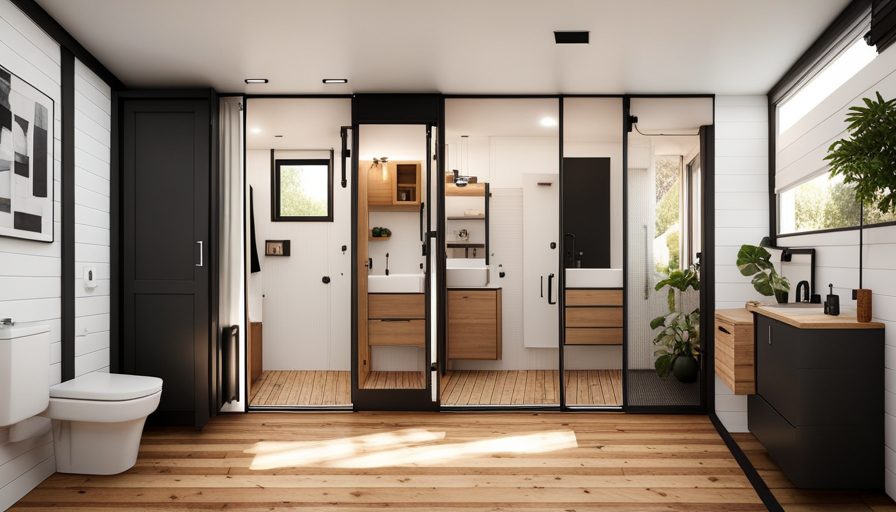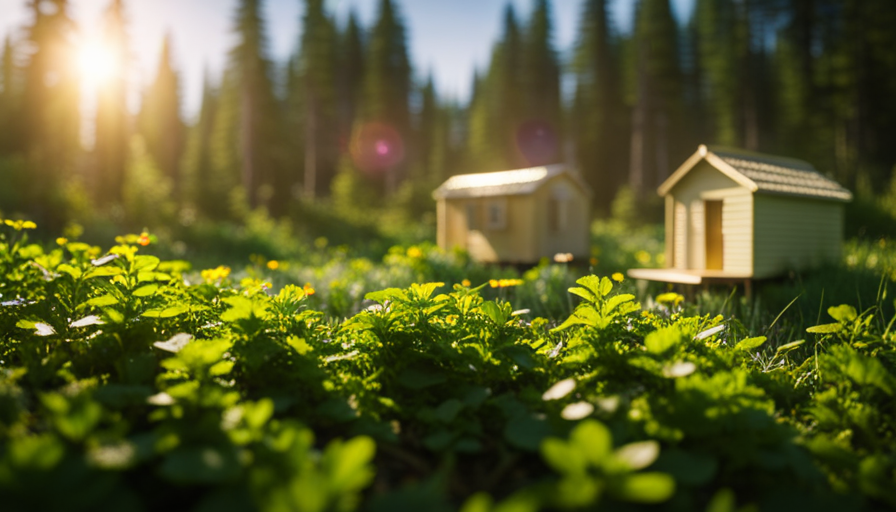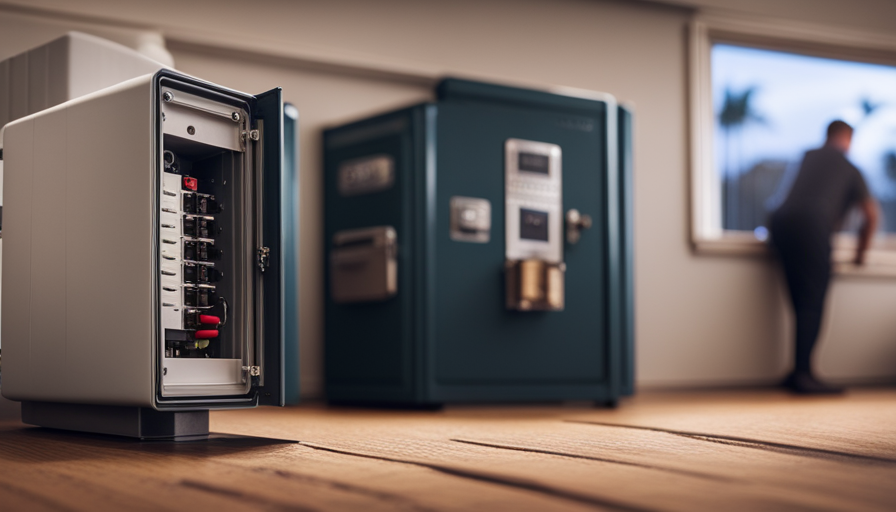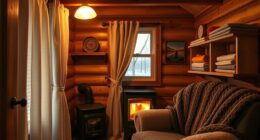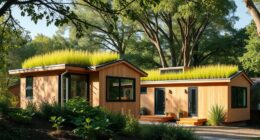In the realm of tiny houses, every square inch is valuable, even the bathroom area. Despite its small size, it is still able to be functional and stylish.
In this article, I’ll take you on a tour of the bathrooms in tiny houses and show you how they are designed to maximize space and efficiency. First and foremost, the bathroom layout in a tiny house is all about making the most of every inch. From clever storage solutions to compact fixtures, you’ll be amazed at how much can be packed into such a small space. And don’t worry, the plumbing systems are just as efficient as any traditional home.
Privacy is also a key consideration in tiny house bathrooms. Whether it’s cleverly placed curtains, sliding doors, or frosted glass, there are plenty of options to ensure your bathroom time remains private.
And let’s not forget about lighting and ventilation. With limited space, it’s important to have proper lighting to make the space feel bigger and brighter. And good ventilation is a must to prevent any unwanted odors or moisture buildup.
In this article, I’ll also provide you with maintenance and cleaning tips specific to tiny house bathrooms, as well as ideas for personalizing and adding style to your tiny bathroom oasis. So let’s dive in and see how the bathrooms in a tiny house can be both practical and beautiful.
Key Takeaways
- Tiny house bathrooms are designed to maximize space and efficiency, with clever storage solutions and compact fixtures.
- Privacy considerations are important, and options like curtains, sliding doors, and frosted glass can be used.
- Proper lighting and ventilation are crucial for space and odor/moisture control in tiny house bathrooms.
- Maintenance and cleaning routines should be simplified, and the use of a dehumidifier can help prevent mold and mildew.
Space-Saving Bathroom Design
The bathrooms in a tiny house are designed to save space without sacrificing functionality. Compact fixtures and clever storage solutions are key in maximizing the limited bathroom space. For example, a small shower stall with a sliding door can be installed to save space compared to a traditional bathtub.
Additionally, a wall-mounted toilet and sink can free up valuable floor space. To make the most of vertical space, shelves and cabinets can be built into the walls or above the toilet. These storage options allow for the organization of toiletries and other bathroom essentials.
The space-saving bathroom design seamlessly transitions into the next section about the functional layout, where every inch of the tiny house is utilized efficiently.
Functional Layout
When designing a compact living space, you’ll appreciate the thoughtfully planned and efficient arrangement of the bathroom. The key to a functional layout in a tiny house bathroom is maximizing storage and incorporating accessibility options. Despite the limited space, there are clever storage solutions that can be utilized to keep all your essentials organized. For example, installing a wall-mounted vanity with drawers and shelves can provide ample storage for toiletries and towels. Additionally, incorporating a medicine cabinet or mirrored cabinet above the sink can help save space while still providing storage. Accessibility options such as grab bars and a curbless shower can also be integrated to ensure safety and ease of use. With these functional storage options and accessibility features, the bathroom in a tiny house can be both practical and efficient. As we move into the next section about efficient plumbing systems, it is important to consider how these elements contribute to the overall design.
Efficient Plumbing Systems
With an efficient plumbing system, you can effortlessly navigate your compact living space, ensuring a seamless flow of water and waste management. This is crucial for water conservation and maintaining an eco-friendly lifestyle.
Here are two key features of an efficient plumbing system in a tiny house:
-
Water-saving fixtures: By using low-flow toilets, faucets, and showerheads, you can minimize water usage without sacrificing functionality. These fixtures are designed to deliver the same level of performance while reducing water consumption.
-
Eco-friendly materials: When constructing the plumbing system, it’s important to choose materials that are sustainable and environmentally friendly. Opting for materials like copper or PEX pipes, which have a longer lifespan and require less energy to manufacture, can significantly reduce the environmental impact.
Efficient plumbing systems not only promote water conservation but also contribute to a sustainable and eco-friendly lifestyle.
Moving on to privacy considerations…
Privacy Considerations
Create a cozy sanctuary where you can retreat and unwind, ensuring your personal space remains uninterrupted.
Privacy concerns are a common consideration when it comes to the bathrooms in a tiny house. To address this, you can opt for a separate bathroom area with a door that provides a sense of seclusion. If space is limited, privacy can still be achieved by using frosted glass or curtains as dividers.
Additionally, utilizing clever storage solutions can help keep your bathroom organized and clutter-free. Consider using wall-mounted shelves or built-in cabinets to maximize space and keep personal items out of sight.
As we transition into the next section about clever lighting and ventilation, it’s important to create a bathroom that not only offers privacy but also promotes comfort and functionality.
Clever Lighting and Ventilation
To ensure a pleasant and refreshing atmosphere, clever lighting and ventilation are essential elements to consider in designing your bathroom sanctuary. Here are four key factors to keep in mind when it comes to smart technology and eco-friendly options:
-
Natural light: Incorporating large windows or skylights can fill your tiny house bathroom with natural light, creating a bright and inviting space.
-
LED lighting: Opt for energy-efficient LED lights that provide ample illumination while reducing electricity consumption.
-
Motion sensors: Install motion sensors to automatically turn on the lights when someone enters the bathroom, saving energy and making it easier to navigate during nighttime visits.
-
Ventilation systems: Choose a ventilation system that efficiently removes excess moisture and odors from the bathroom, preventing mold and maintaining a fresh environment.
With smart lighting and ventilation options, your tiny house bathroom will be both functional and environmentally friendly.
Transitioning into the subsequent section about maintenance and cleaning tips, let’s explore some simple ways to keep your bathroom spotless and well-maintained.
Maintenance and Cleaning Tips
When it comes to maintaining and cleaning a tiny house, I’ve found that having a simplified cleaning routine is key. I’ve developed a system that allows me to quickly and efficiently clean my space on a regular basis.
Additionally, I’ve learned the importance of preventing mold and mildew in a tiny house, as the compact nature of the space can make it more susceptible to these issues. By following a few simple steps, I’ve been able to keep my tiny house clean and mold-free.
Simplified Cleaning Routine
Maintaining the cleanliness of the bathrooms in a tiny house is made easier with a simplified cleaning routine. With limited space, it’s important to keep the bathroom tidy and organized. A minimalist storage approach helps to eliminate clutter and make cleaning more efficient. I recommend using eco-friendly materials, such as natural cleaners and biodegradable wipes, to minimize environmental impact. To further simplify cleaning, I have developed a 3-column, 3-row table to help you stay on track:
| Task | Frequency | Time Required |
|---|---|---|
| Wipe surfaces | Daily | 5 minutes |
| Scrub toilet | Weekly | 10 minutes |
| Clean shower | Monthly | 15 minutes |
By following this routine, you can keep your tiny house bathroom clean without spending too much time or effort. Now, let’s move on to preventing mold and mildew to ensure a hygienic bathroom environment.
Preventing Mold and Mildew
To ensure a healthy and pleasant bathroom experience, it’s important for you to be vigilant in preventing the growth of mold and mildew. This will create an environment that is both inviting and safe. Here are some practical tips to help you prevent moisture buildup and maintain effective ventilation in your tiny house bathroom:
-
Use a dehumidifier to reduce humidity levels.
-
Install an exhaust fan to remove excess moisture.
-
Regularly clean and dry surfaces to prevent mold growth.
By following these steps, you can effectively prevent mold and mildew from taking hold in your tiny house bathroom.
Now that we’ve covered the importance of preventing moisture, let’s move on to the next section about personalization and style.
Personalization and Style
If you’re looking to add a touch of personalization and style to your tiny house, the bathrooms offer endless opportunities to showcase your creativity and make a statement.
Did you know that 75% of tiny house owners prioritize unique and stylish bathrooms in their design? With customizable fixtures and clever storage solutions, you can create a bathroom that reflects your personality and meets your needs.
From choosing a unique sink and faucet combination to installing a custom-designed shower enclosure, the possibilities are endless.
Don’t forget about storage – utilize vertical space with wall-mounted shelves or opt for multi-functional furniture that doubles as storage.
By incorporating your personal style into the bathroom, you can create a space that is not only functional but also visually appealing.
Frequently Asked Questions
Can a tiny house bathroom accommodate a bathtub?
Yes, a tiny house bathroom can accommodate a bathtub, but it might require some creativity. If space is limited, you can consider bathtub alternatives like a compact shower stall or a Japanese soaking tub. There are also space-saving bathroom fixtures available, such as corner sinks and toilets, that can help maximize the available space. It’s important to prioritize functionality and efficiency when designing a tiny house bathroom.
How do you prevent moisture buildup in a tiny house bathroom?
To prevent moisture buildup in a tiny house bathroom, there are a few key steps I take.
First, I make sure to use proper ventilation options like a fan or window to allow for air circulation.
Additionally, I choose materials that are resistant to moisture, such as waterproof paint or tiles.
Finally, I regularly check for any leaks or water damage to address them promptly.
These precautions ensure a dry and comfortable bathroom experience.
Are there any options for adding a bidet in a tiny house bathroom?
There are several bidet options available for tiny house bathrooms despite space limitations. One option is a bidet attachment that can be installed on your existing toilet seat, taking up minimal space.
Another option is a portable bidet that can be stored when not in use.
Additionally, there are bidet toilet combos specifically designed for small spaces.
These options provide the convenience and hygiene of a bidet without compromising on space in your tiny house bathroom.
What are some creative storage solutions for toiletries and bathroom essentials in a tiny house bathroom?
In a tiny house bathroom, maximizing space is crucial. Luckily, there are plenty of creative storage ideas for toiletries that can help keep your bathroom organized.
Consider using wall-mounted shelves or baskets to store items vertically, utilizing the space above the toilet or sink.
You can also attach magnetic strips to the inside of cabinet doors to hold metal items like tweezers or nail clippers.
Additionally, using a shower caddy with suction cups can free up valuable shower space.
Can you install a composting toilet in a tiny house bathroom?
Yes, you can definitely install a composting toilet in a tiny house bathroom. Composting toilets offer several benefits such as saving water, being eco-friendly, and producing nutrient-rich compost. They’re a great alternative to traditional flush toilets and can be easily installed in small spaces. Composting toilets are practical for tiny house living as they don’t require plumbing connections and can handle waste effectively.
Conclusion
In conclusion, the bathrooms in tiny houses may be small in size, but they’re big on efficiency and functionality. With space-saving designs, clever lighting and ventilation, and efficient plumbing systems, these bathrooms are designed to make the most of limited space.
One interesting statistic to note is that despite their small size, tiny house bathrooms are able to save up to 30% more water compared to traditional bathrooms. This highlights the importance of sustainable living and making conscious choices even in our smallest spaces.
Hi, I’m Emma. I’m the Editor in Chief of Tiny House 43, a blog all about tiny houses. While tree houses are often associated with childhood, they can be the perfect adult retreat. They offer a cozy space to relax and unwind, surrounded by nature. And since they’re typically built on stilts or raised platforms, they offer stunning views that traditional homes simply can’t match. If you’re looking for a unique and romantic getaway, a tree house tiny house might just be the perfect option.
